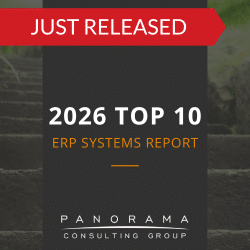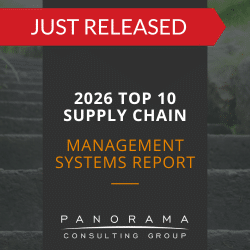Effectively managing employees’ attitudes and involvement as your company explores new business software is the key to implementation success.
However, many executives don’t subscribe to this mindset. This puts project managers in a tough spot – they know they need adequate budget and resources for preparing employees for change, but they’re not sure how to convey the tangible benefits of this approach.
Today, we’re outlining these benefits and providing tips for requesting the support you need to make these benefits a reality.
The Advantages of Change Management: Putting People First
The process of managing the “people” aspects of business change is known as organizational change management. This is the term we will use throughout this post, but it’s not necessarily a useful term to use as you talk to executives. As you communicate the following benefits, avoid nebulous buzzwords where you can.
1. Reducing Change Resistance
Resistance to change is a natural human reaction, often stemming from fear of the unknown or discomfort with new ways of working. Change resistance is a common challenge during enterprise software implementations and other transformative initiatives.
Developing a change management plan can help you prevent show-stopping levels of resistance. This plan should outline strategies for helping employees understand the reasons for change and addressing their concerns before, during, and after the project.
When our ERP consultants work with clients, we help them develop a communication strategy that addresses the concerns of different stakeholder groups. This ensures that all employees feel supported and fosters more positive attitudes towards the change.
ERP Training Plan Success Story
We helped this manufacturer implement an ERP training strategy to increase user adoption of its new ERP system.
2. Enhanced Employee Morale and Engagement
Change management plays a crucial role in maintaining employee morale during times of change. When you keep employees informed and you generate enthusiasm for the changes, employees are more likely to get involved in the change process. This fosters a sense of ownership and accountability.
Employee involvement can range anywhere from simply being receptive to project communications to providing first-hand insights into the specific challenges their department is facing.
For example, during the software evaluation stage, you could seek input from various departments by asking about pain points and suggestions for improving efficiency.
Then, you could engage employees throughout the selection and implementation stages by involving them in software demos, system testing, and more.
3. Amplifying Benefits Realization
When organizations undertake changes—whether through ERP implementations or process improvements—they expect to see tangible benefits.
Developing a change management strategy helps ensure these goals are met. This strategy serves as a structured approach for engaging employees, providing user training, and communicating with all stakeholders.
In our experience, many organizations introduce changes without a structured approach. Low user adoption usually results.
To ensure high user adoption and benefits retaliation, we recommend developing a plan that aligns employee behaviors and attitudes with your project goals.
For example, a pharmaceutical company might implement a supply chain management system to streamline supplier management. By providing training and support to all affected employees, the company could maximize adoption of processes and systems, resulting in benefits, such as reduced lead times.
4. Facilitating Future Changes
Effective change management not only addresses current transitions but also prepares team members for future changes. This is one of the most compelling advantages of change management.
By using change management principles to build a culture that embraces change, your company can become more adaptable to market changes, internal shifts, and technological advancements.
Organizations that can navigate change smoothly are better positioned to innovate and stay ahead of the competition.
How to Communicate the Benefits of Change Management
The key to promoting the concept of change management may be to avoid talking about change management.
Instead, start with what senior leaders care about: achieving business benefits. With the following questions, you can tie specific change management activities directly to tangible business benefits.
Question 1: What is the project trying to achieve?
This is a two-fold question and one that is often unasked. It’s not just useful in outlining the benefits of change management, but it’s also critical for leaders to understand, in general. After all, if they don’t know what the project is trying to achieve, how will they measure the effectiveness of change management efforts?
a. What are the organizational benefits of this project?
Organizational benefits are the higher-level reasons for implementing ERP software or making other organizational changes. These benefits could include increasing revenue, achieving compliance with regulations, or strengthening customer satisfaction.
b. What are the specific objectives of this project?
Specific objectives are the outcomes the project will produce. These are usually specific and measurable outcomes that ultimately lead to achievement of organizational benefits.
Question 2: How much of this benefit depends on adoption and usage?
Once you’ve defined the benefits and objectives of the project, you can move on to tying those objectives to people.
If your project is primarily focused on something technical, like increasing server storage, then business benefits have very low dependency on end-user adoption.
However, if your project is primarily focused on streamlining communication, for example, then business benefits will depend highly on the people who need to adopt the new practices.
This is where scoping the change comes into play. Scoping helps you determine what level of change management is necessary and helps you identify change management tools and resources you will need to achieve project goals.
Question 3: What percentage of this benefit will we achieve if no one changes how they do their job?
Similar to the prior question, you will want to ask this question for each benefit and objective.
If you’re implementing an ERP system and no one adopts it, you might achieve between 80% and 100% of a technical-related benefit. However, you’ll capture only a small portion of other types of benefits.
In reality, it’s unlikely that no one will adopt the changes, but by asking this question, you have a baseline for measuring the impact of change management.
Learn More About the Strategic Advantage of Change Management
Organizations that prioritize change management can make their operations more effective and efficient. This is not just about ensuring smooth transitions; it’s about using a structured approach to drive significant business benefits.
Contact our organizational change management consultants below to start integrating these practices into the early stages of your project.














